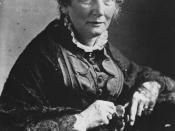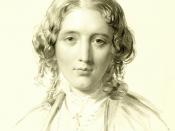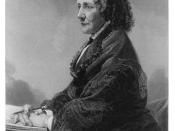When most people hear the name Harriet Beecher Stowe, they think not of the woman herself but of her most famous creation, Uncle Tom's Cabin: Or, Life Among the Lowly (1851-1852). Nearly every American is familiar with this novel's staunch abolitionist stance and the role it had in shaping the antebellum popular imagination. The blatant sentimentality of the book--its flagrantly emotional appeal to popular tastes--and its deft manipulation of stereotypes in its portrayal of African Americans have served to obscure Stowe's achievements. (Adams, 1963) Even Abraham Lincoln's praise for her as "the little woman" who was responsible for the Civil War has a condescending ring to it.
Early Life
Lyman Beecher, Harriet Beecher's father, was a stern New England Calvinist preacher whose image of a God who predestined humans to heaven or hell left a mark on his children. The fact that Harriet's mother died when she was four made Harriet's father's influence even more important.
By the age of six and a half, the young "Hattie," as she was known to her family, had memorized more than two dozen hymns and several long chapters in the Bible. (Crozier, 1969) As an adult, however, Harriet Beecher would substitute for her father's dogmas a religion of hope that stressed the love and compassion of Christ rather than the divine judgment that her father preached. Some people hold that she "feminized" her father's religion. (Ammons, 1980) Throughout her life, she retained a strong sense of religious mission and zeal for social improvement.
At age twelve, Harriet moved to Hartford to live with her older sister Catharine, a purposeful woman who had started the Hartford Female Seminary. Harriet attended Catharine's school and stayed on as a teacher and guardian of young children. In 1832, she moved with her family to Cincinnati, Ohio,


